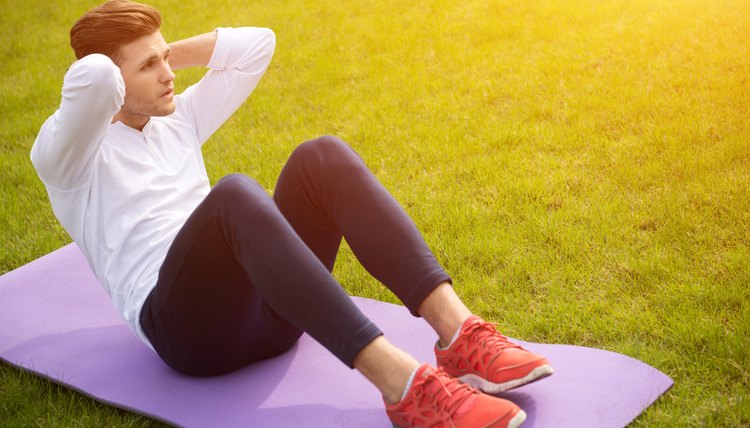Curlups vs. Situps

Abdominal curl-ups and sit-ups are two important abdominal movements and stomach-toning exercises. Both of these exercises strengthen the main muscles in your abdomen without the use of equipment and are easy to complete. Learning the benefits of each exercise will help you decide which one is the best for you.
Curl-up
A curl-up is also known as an abdominal crunch. This half-sit-up exercise is used as a test for abdominal strength, but is also used as an exercise to tone your stomach. Perform the curl-up from a face-up position on the floor. Lie on your back with your knees bent and feet flat on the floor. Position your straight arms at your sides or bend your elbows and place your hands behind your head. Exhale and curl your trunk as you aim to lift your shoulder blades off the floor, keeping your low back flat on the floor. Inhale and lower your upper back to the floor.
Sit-up
The sit-up is a full movement from a face-up to an upright-torso position. The sit-up is performed with the legs straight out onto the floor or with the knees bent and feet flat on the floor. The leg position is different from the curl-up which always has the knees bent. Place your hands behind your head with the elbows pointing out to the sides or with your arms across your chest. Exhale and tilt your hips to straighten your spine as you sit up and bring your torso toward your legs. Inhale and slowly lower your torso to start position.

Sit-ups are a great abdominal exercise
Muscles
The rectus abdominis is the main muscle used in both the curl-up and sit-up exercises. The rectus abdominis begins on the lower portion of your ribs, travels down the center of your stomach and attaches to your pelvis. When this muscle contracts, the distance between your ribs and hips shortens, as in the curl-up and the sit-up. Researchers A. Rutkowska-Kucharska and A. Szpala studied how different arm positions affected the curl-ups use of the rectus abdominis. The results, presented in the November 2010 issue of "Journal of Strength and Conditioning Research," show that curl-ups with arms extended above the head activate the greatest contraction in the rectus abdominis. The obliques contract throughout the sit-up and the curl-up exercise. The hip flexors at the tops of your thighs contract during the full sit-up.

Sit-ups are a great abdominal exercise
Back
The abdominal sit-up places more of a risk on your back than a curl-up. If your hip flexors are weak and unable to hold your pelvis in a position that keeps your spine straight, a sit-up places your back in a hyperextended position. When you lift your torso with your back in an overextended position, you may experience back pain. If your back already hurts, perform the curl-up instead of the sit-up to strengthen your stomach and protect your back.
Writer Bio
A mother of two and passionate fitness presenter, Lisa M. Wolfe had her first fitness article published in 2001. She is the author of six fitness books and holds an Associate of Arts in exercise science from Oakland Community College. When not writing, Wolfe is hula-hooping, kayaking, walking or cycling.
